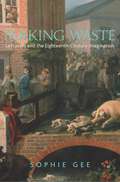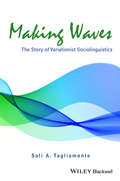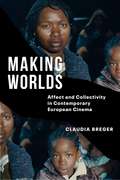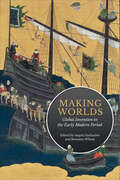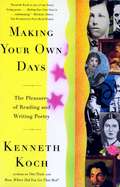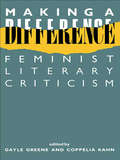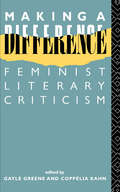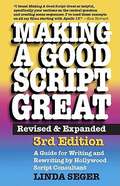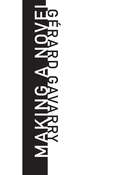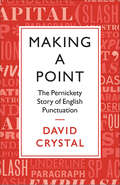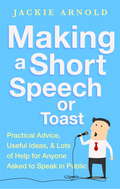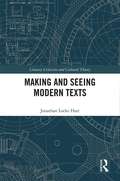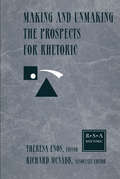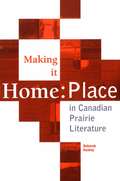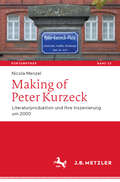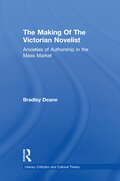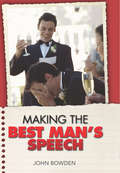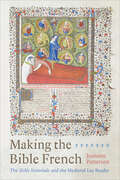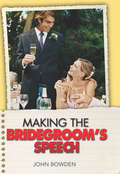- Table View
- List View
Making Waste: Leftovers and the Eighteenth-Century Imagination
by Sophie GeeThe obsession with waste in eighteenth-century English literatureWhy was eighteenth-century English culture so fascinated with the things its society discarded? Why did Restoration and Augustan writers such as Milton, Dryden, Swift, and Pope describe, catalog, and memorialize the waste matter that their social and political worlds wanted to get rid of—from the theological dregs in Paradise Lost to the excrements in "The Lady's Dressing Room" and the corpses of A Journal of the Plague Year? In Making Waste, the first book about refuse and its place in Enlightenment literature and culture, Sophie Gee examines the meaning of waste at the moment when the early modern world was turning modern.Gee explains how English writers used contemporary theological and philosophical texts about unwanted and leftover matter to explore secular, literary relationships between waste and value. She finds that, in the eighteenth century, waste was as culturally valuable as it was practically worthless—and that waste paradoxically revealed the things that the culture cherished most.The surprising central insight of Making Waste is that the creation of value always generates waste. Waste is therefore a sign—though a perverse one—that value and meaning have been made. Even when it appears to symbolize civic, economic, and political failure, waste is in fact restorative, a sign of cultural invigoration and imaginative abundance. Challenging the conventional association of Enlightenment culture with political and social improvement, and scientific and commercial progress, Making Waste has important insights for cultural and intellectual history as well as literary studies.
Making Waves: The Story of Variationist Sociolinguistics
by Sali A. TagliamonteMaking Waves tells the human story of an academic field based on one-to-one interviews with 43 of the most famous scholars in Variationist Sociolinguistics. Explanations of concepts, ideas, good practice and sage advice come directly from the progenitors of the discipline. An authentic, inside story about the origins of Sociolinguistics as Language Variation and Change, recording the context and spirit of sociolinguistics Gives students access to the views on language variation of major sociolinguists such as Bill Labov and Peter Trudgill Offers a human story of an academic field, and is written in the style of a novel, offering complete accessibility with minimal in-group terminology Provides a timely audio archive of the reminiscences of the major Sociolinguists, including Labov, Fasold, Milroy, Trudgill, and Wolfram, with a companion website featuring 400 audio clips from the interviews. Visit the site at www.wiley.com/go/tagliamonte/makingwaves
Making Worlds: Affect and Collectivity in Contemporary European Cinema
by Claudia BregerThe twenty-first century has witnessed a resurgence of economic inequality, racial exclusion, and political hatred, causing questions of collective identity and belonging to assume new urgency. In Making Worlds, Claudia Breger argues that contemporary European cinema provides ways of thinking about and feeling collectivity that can challenge these political trends.Breger offers nuanced readings of major contemporary films such as Michael Haneke’s The White Ribbon, Alejandro González Iñárritu’s Biutiful, Fatih Akın’s The Edge of Heaven, Asghar Farhadi’s A Separation, and Aki Kaurismäki’s refugee trilogy, as well as works by Jean-Luc Godard and Rainer Werner Fassbinder. Through a new model of cinematic worldmaking, Breger examines the ways in which these works produce unexpected and destabilizing affects that invite viewers to imagine new connections among individuals or groups. These films and their depictions of refugees, immigrants, and communities do not simply counter dominant political imaginaries of hate and fear with calls for empathy or solidarity. Instead, they produce layered sensibilities that offer the potential for greater openness to others’ present, past, and future claims. Drawing on the work of Latour, Deleuze, and Rancière, Breger engages questions of genre and realism along with the legacies of cinematic modernism. Offering a rich account of contemporary film, Making Worlds theorizes the cinematic creation of imaginative spaces in order to find new ways of responding to political hatred.
Making Worlds: Global Invention in the Early Modern Period (UCLA Clark Memorial Library Series)
by Angela Vanhaelen Bronwen WilsonTaking into account the destructive powers of globalization, Making Worlds considers the interconnectedness of the world in the early modern period. This collection examines the interdisciplinary phenomenon of making worlds, with essays from scholars of history, literary studies, theatre and performance, art history, and anthropology. The volume advances questions about the history of globalization by focusing on how the expansion of global transit offered possibilities for interactions that included the testing of local identities through inventive experimentation with new and various forms of culture. Case studies show how the imposition of European economic, religious, political, and military models on other parts of the world unleashed unprecedented forces of invention as institutionalized powers came up against the creativity of peoples, cultural practices, materials, and techniques of making. In doing so, Making Worlds offers an important rethinking of how early globalization inconsistently generated ongoing dynamics of making, unmaking, and remaking worlds.
Making Your Own Days: The Pleasures of Reading and Writing Poetry
by Kenneth KochFrom one of the most esteemed American poets of the twenty-first century comes a celebration of poetry and an invitation for anyone to experience its beauty and wonder. Full of fresh and exciting insights, Making Your Own Days illuminates the somewhat mysterious subject of poetry for those who read it and for those who write it--as well as for those who would like to read and write it better. By treating poetry not as a special use of language but as a distinct language--unlike the one used in prose and conversation--Koch clarifies the nature of poetic inspiration, how poems are written and revised, and what happens to the heart and mind while reading a poem. Koch also provides a rich anthology of more than ninety works from poets past and present. Lyric poems, excerpts from long poems and poetic plays, poems in English, and poems in translation from Homer and Sappho to Lorca, Snyder, and Ashbery; each selection is accompanied by an explanatory note designed to complement and clarify the text and to put pleasure back into the experience of poetry.
Making a Difference: Feminist Literary Criticism (New Accents Ser.)
by Gayle Greene Coppelia KahnFirst published in 2002. Routledge is an imprint of Taylor & Francis, an informa company.
Making a Difference: Feminist Literary Criticism (New Accents)
by GAYLE GREENE; COPPÉLIA KAHNFeminist scholarship employs gender as a fundamental organizing category of human experience, holding two related premises: men and women have different perceptions or experiences in the same contexts, the male perspective having been dominant in fields of knowledge; and that gender is not a natural fact but a social construct, a subject to study in any humanistic discipline. This challenging collection of essays by prominent feminist literary critics offers a comprehensive introduction to modes of critical practice being used to trace the construction of gender in literature. The collection provides an invaluable overview of current femionist critical thinking. Its essays address a wide range of topics: the rerlevance of gender scholarship in the social sciences to literary criticism; the tradition of women's literature and its relation to the canon; the politics of language; French theories of the feminine; psychoanalysis and feminism; feminist criticism of writing by lesbians and black women; the relationship between female subjectivity, class, and sexuality; feminist readings of the canon.
Making a Good Script Great (3rd edition)
by Linda SegerThis book takes you through the whole screenwriting process--from initial concept through final rewrite--providing specific methods that will help you craft tighter, stronger, and more saleable scripts.
Making a Novel
by Jane Kuntz Gérard GavarryMoving back and forth between detailed explanation and personal anecdotes, Ge´rard Gavarry's Making a Novel is partly a memoir of a writer's life and partly a memoir of his work, showing us how every story, no matter how well-planned, could always have been written countless other ways.
Making a Novel
by Jane Kuntz Gérard GavarryMoving back and forth between detailed explanation and personal anecdotes, Ge´rard Gavarry's Making a Novel is partly a memoir of a writer's life and partly a memoir of his work, showing us how every story, no matter how well-planned, could always have been written countless other ways.
Making a Novel
by Jane Kuntz Gérard GavarryMoving back and forth between detailed explanation and personal anecdotes, Ge´rard Gavarry's Making a Novel is partly a memoir of a writer's life and partly a memoir of his work, showing us how every story, no matter how well-planned, could always have been written countless other ways.
Making a Point: The Persnickety Story of English Punctuation
by David CrystalThe triumphant concluding volume in David Crystal's classic trilogy on the English language combines the first history of English punctuation with a complete guide on how to use it. Behind every punctuation mark lies a thousand stories. The punctuation of English, marked with occasional rationality, is founded on arbitrariness and littered with oddities. For a system of a few dozen marks it generates a disproportionate degree of uncertainty and passion, inspiring organizations like the Apostrophe Protection Society and sending enthusiasts, correction-pens in hand, in a crusade against error across the United States. Professor Crystal leads us through this minefield with characteristic wit, clarity, and commonsense. In David Crystal's Making a Point, he gives a fascinating account of the origin and progress of every kind of punctuation mark over one and a half millennia and offers sound advice on how punctuation may be used to meet the needs of every occasion and context.
Making a Short Speech or Toast: Practical advice, useful ideas and lots of help for anyone asked to speak in public
by Jackie ArnoldMost people are called upon to make a speech or toast at some point in their lives. This book will help the inexperienced speaker to stand up with confidence, and deliver a really effective speech or toast that is appropriate for the occasion. It also contains a variety of toasts and quotes to help those with more experience in public speaking.There are guidelines on how to prepare and deliver a mini speech, including tips on introducing humour and how to avoid embarrassing your audience with inappropriate material. A special section includes interesting quotes and toasts to insert into a wedding speech, whether it's by the best man or woman, bridegroom or father of the bride. A workbook section helps the reader with ideas for appropriate beginnings and endings to speeches. There is even an A-Z of sample toasts for all occasions including anniversaries, achievements, and business occasions; and for a range of subjects such as love, life, and friendship.
Making a Short Speech or Toast: Practical advice, useful ideas and lots of help for anyone asked to speak in public
by Jackie ArnoldMost people are called upon to make a speech or toast at some point in their lives. This book will help the inexperienced speaker to stand up with confidence, and deliver a really effective speech or toast that is appropriate for the occasion. It also contains a variety of toasts and quotes to help those with more experience in public speaking.There are guidelines on how to prepare and deliver a mini speech, including tips on introducing humour and how to avoid embarrassing your audience with inappropriate material. A special section includes interesting quotes and toasts to insert into a wedding speech, whether it's by the best man or woman, bridegroom or father of the bride. A workbook section helps the reader with ideas for appropriate beginnings and endings to speeches. There is even an A-Z of sample toasts for all occasions including anniversaries, achievements, and business occasions; and for a range of subjects such as love, life, and friendship.
Making and Seeing Modern Texts (Literary Criticism and Cultural Theory)
by Jonathan Locke HartMaking and Seeing Modern Texts explores the poetics of texts through a close reading and analysis across the genres of poetry, drama, fiction, non-fiction travel literature and theory. This volume demonstrates that prose, as much as poetry, share the making and seeing of language, literary practice, and theory. Genre, then, is presented as a guide that crosses multiple boundaries. This volume selects different ways to examine texts, discussing Michael Ondaatje’s early poetry and examining narrative in Philip Roth’s The Human Stain. The book examines images in poetry, narrative in fiction, prefaces in non-fiction, metatheatre in drama, and attempts to see the modern and postmodern in theory, all of which show us the complexities of modernity or later modernity. One of the innovations is that the author, a literary critic/theorist, poet and historian, takes his training in practice and theory and shows, through examples of each, how language operates across genres.
Making and Unmaking the Prospects for Rhetoric: Selected Papers From the 1996 Rhetoric Society of America Conference
by Carolyn Miller Roxanne Mountford Theresa Enos Richard McNabbThe 1996 Meeting of the Rhetoric Society of America commemorated the 25th anniversary of the publication of Lloyd Bitzer and Edwin Black's The Prospect of Rhetoric. In so doing, the conference gave scholars and teachers in various disciplines from all over the country the opportunity to talk about new prospects for rhetoric. The conferees were asked to present their vision of rhetoric studies or to demonstrate what rhetoric studies could be by example. Their essays, presented in this volume, illustrate a discipline at odds over the future and demonstrate the continued influence and vitality of other papers, on the same subject, published some 25 years ago.
Making it Home: Place in Canadian Literature
by Deborah KeaheyTraditional approaches to Prairie literature have focussed on the significance of "the land" in attempts to make a place into a home. The emphasis on the importance of landscape as a defining feature ignores the important roles played by other influences brought to the land such as history, culture, gender, ethnicity, religion, community, family, and occupation. Deborah Keahey considers over 70 years of Canadian Prairie literature, including poetry, autobiography, drama, and fiction. The 17 writers range from the well-established, like Martha Ostenso and Robert Kroetsch, to newer writers, like Ian Ross and Kelly Rebar. Through their works, she asks whether the Prairies are a physical or a political creation, whether "home" is made by what you bring with you, or what you find when you arrive, and she incorporates the influences and effects far beyond landscape to understand what guides the "home-making" process of both the writers and their creations. Her study acknowledges that "home" is a complicated concept, and making a place into a home place is a complicated process. Informed by current linguistic, feminist, postcolonial, and cultural theory, Keahey explores these concepts in depth and redefines our understanding of place, home, and the relationship between them.
Making of Peter Kurzeck: Literaturproduktion und ihre Inszenierung um 2000 (Kontemporär. Schriften zur deutschsprachigen Gegenwartsliteratur #22)
by Nicola MenzelDie Studie untersucht die öffentliche Darstellung des Schreibprozesses Peter Kurzecks. Seine mehrbändige autofiktionale Romanreihe Das alte Jahrhundert sowie seine frei eingesprochenen Hörbücher wurden im Feuilleton einhellig als außergewöhnlich besprochen. Sie gelten als authentische Rarität in einem sich ansonsten zunehmend popularisierendem Literaturbetrieb. Die Arbeit zeigt hingegen, dass das Phänomen Kurzeck keinesfalls abseits eines ökonomisierten und medialisierten gegenwartskulturellen Feldes steht. Vielmehr lassen sich typische populäre und ökonomische Mechanismen ablesen wie u.a. Mehrfachadressierung, Zweitverwertung, Serialität und Fankultur. Auch das Phänomen Kurzeck selbst wirkt auf das Feld ein, von dem es sich abzusondern scheint, und zwar nicht trotz des autonomieästhetischen Gestus, sondern gerade deswegen. Kurzeck wird mithin als gegenwartsästhetisches Phänomen untersucht, bei dem Marktdistinktion zum Verkaufsargument wird.Exemplarisch an Kurzeck wird gezeigt, dass sich Formationen des gegenwartskulturellen Feldes um 2000 auch dort ablesen lassen, wo sie nicht erwartet werden. Die Arbeit regt dazu an, einen emphatischen Literaturbegriff als grundsätzlich produzierbar und konsumierbar zu verstehen, mit Blick auf Kurzeck als werkpolitischer Effekt der Selbst- und Schreibdarstellung einer Autorfigur. Als Beitrag zur Gegenwartsliteraturforschung regt sie darüber hinaus zur Reflexion der literaturwissenschaftlichen Haltung gegenüber ihrem Gegenstand und den eigenen Forschungspraktiken an.Methodisch verbindet sie feldtheoretische Fragen mit close readings nicht nur literarischer Texte und ihrer Vorarbeiten aus dem Nachlass Kurzecks, sondern auch von Interviews, Preisreden, Videoaufnahmen von Lesungen, einem öffentlichen Manuskriptdiktat im Frankfurter Literaturhaus sowie der Peter-Kurzeck-App. Das dafür entwickelte umfassende methodische Modell stellt einen generellen Vorschlag dar zur Analyse gegenwartsliterarischer Gegenstände, bei der literaturwissenschaftliche Methoden mit ökonomischen, paratextuellen, soziologischen, praxeologischen und kulturästhetischen Aspekten im Dialog stehen.
Making of the Victorian Novelist: Anxieties of Authorship in the Mass Market (Literary Criticism and Cultural Theory)
by Bradley DeaneFirst Published in 2003. Routledge is an imprint of Taylor & Francis, an informa company.
Making the Best Man's Speech
by John BowdenThis is a guide for prospective "best men" which aims to answer the anxieties about making the speech. It offers advice on speech-making essentials, great openings, strong middles, big finishes, plus putting it all together and delivering the speech itself.
Making the Best Man's Speech
by John BowdenThis is a guide for prospective "best men" which aims to answer the anxieties about making the speech. It offers advice on speech-making essentials, great openings, strong middles, big finishes, plus putting it all together and delivering the speech itself.
Making the Bible French: The Bible historiale and the Medieval Lay Reader
by Jeanette PattersonFrom the end of the thirteenth century to the first decades of the sixteenth century, Guyart des Moulins’s Bible historiale was the predominant French translation of the Bible. Enhancing his translation with techniques borrowed from scholastic study, vernacular preaching, and secular fiction, Guyart produced one of the most popular, most widely copied French-language texts of the later Middle Ages. Making the Bible French investigates how Guyart’s first-person authorial voice narrates translation choices in terms of anticipated reader reactions and frames the biblical text as an object of dialogue with his readers. It examines the translator’s narrative strategies to aid readers’ visualization of biblical stories, to encourage their identification with its characters, and to practice patient, self-reflexive reading. Finally, it traces how the Bible historiale manuscript tradition adapts and individualizes the Bible for each new intended reader, defying modern print-based and text-centred ideas about the Bible, canonicity, and translation.
Making the Bridegroom's Speech
by John BowdenWhat are the golden rules of speech making? How should you respond to the toast to the bride and groom? And which people do you need to thank and how? The answers to all these questions and more are here in this much-needed book. Now you can make your wedding day speech memorable for all the right reasons!-- Add sincerity, sparkle and humor-- Enjoy the big dayContents: Learning the essentials; conveying your feelings to guests; adding a little humour; finding the ideal beginning and ending; putting it all together; getting the delivery right; stories, jokes and one-liners for your speech; sample speeches.
Making the Bridegroom's Speech (Things That Really Matter About Ser.)
by John BowdenWhat are the golden rules of speech making? How should you respond to the toast to the bride and groom? And which people do you need to thank and how? The answers to all these questions and more are here in this much-needed book. Now you can make your wedding day speech memorable for all the right reasons!-- Add sincerity, sparkle and humor-- Enjoy the big dayContents: Learning the essentials; conveying your feelings to guests; adding a little humour; finding the ideal beginning and ending; putting it all together; getting the delivery right; stories, jokes and one-liners for your speech; sample speeches.
